You searched for: ������������A
<< Previous | Displaying results 6421-6430 of 6705 for "������������A" | Next >>
-
Flag graphic for US 9th Armored Division
PhotoA digital representation of the United States 9th Armored Division's flag. The US 9th Armored Division was known as the "Phantom" division. During World War II, they were involved in the Battle of the Bulge and also liberated Zwodau and Falkenau an der Eger, two subcamps of Flossenbürg. The 9th Armored Division was recognized as a liberating unit in 1993 by the United States Army Center of Military History and the United States Holocaust Memorial Museum (USHMM).

-
Former gas chamber in the Auschwitz main camp
PhotoPostwar photograph of gas chamber for mass murder in the Auschwitz main camp. Poland, ca. 1947. In mid-August 1940, Auschwitz concentration camp authorities put into operation a crematorium adjacent to a morgue. This building was located just outside the boundaries of the Auschwitz main camp. In September 1941, the morgue was converted to a gas chamber for mass murder where several hundred people could be killed at a time. This gas chamber was used until December 1942, though the crematorium remained…
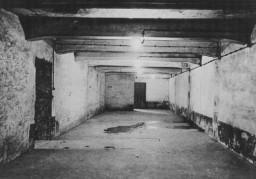
-
Thomas Buergenthal with one of his grandchildren
PhotoThomas with Eliza, one of his grandchildren. 1996. With the end of World War II and collapse of the Nazi regime, survivors of the Holocaust faced the daunting task of rebuilding their lives. With little in the way of financial resources and few, if any, surviving family members, most eventually emigrated from Europe to start their lives again. Between 1945 and 1952, more than 80,000 Holocaust survivors immigrated to the United States. Thomas was one of them.
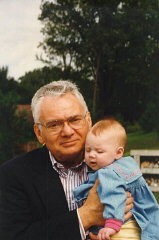
-
German General Headquarters, World War I
PhotoPictured from left to right: Field Marshal Paul von Hindenburg, Kaiser Wilhelm II, and General Erich Ludendorff study maps during World War I. January 1917.
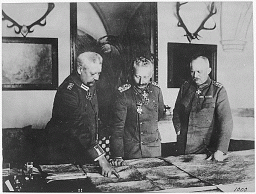
-
Paul von Hindenburg, 1917
PhotoField Marshal Paul von Hindenburg walks along a flower-covered path on his 70th birthday. On either side, crowds of children cheer. October 2, 1917. Hindenburg will later be elected president of Germany in 1925, during the Weimar Republic. © IWM Q 23976
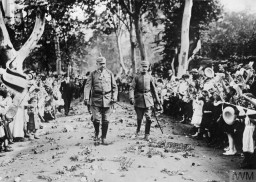
-
Demonstration in Berlin, November 1918
PhotoA public demonstration is held on the Unter den Linden in Berlin on November 9, 1918. On this day, Kaiser Wilhelm II abdicated the throne after a recent naval mutiny in Kiel inspired widespread revolution. © IWM Q 88164
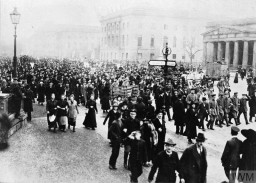
-
British soldiers transfer Jewish refugee children from the ship Theodor Herzl
PhotoIn April 1947, the British Navy intercepted the ship Theodor Herzl en route from Europe to British-controlled Mandatory Palestine. On board were hundreds of Holocaust survivors, including children, seeking a home. This photograph shows British soldiers transferring some of the Jewish refugee children to a vessel for deportation to Cyprus detention camps. Haifa port, British-controlled Mandatory Palestine, April 1947.

-
Nazi-era Antisemitic Propaganda Poster
PhotoNazi propaganda cartoon by Seppla (Josef Plank), a political cartoonist. Germany, date uncertain [probably during World War II]. Beginning in the 1920s, Nazi propagandists promoted the antisemitic myth that Jews were engaged in a massive conspiracy to take over the world. This false notion alleged that “international Jewry” used various people and groups as part of a plan for global conquest. At the time, an octopus extending its tentacles over the globe was a common visual metaphor for this…
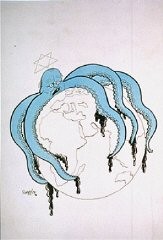
-
Adolf Hitler passes through the Brandenburg Gate on his way to the opening ceremonies of the Olympic Games
PhotoAdolf Hitler passes through the Brandenburg Gate on the way to the opening ceremonies of the Olympic Games. Berlin, Germany, August 1, 1936.
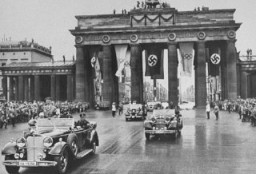
-
Dr. Robert Ritter visits a "Gypsy camp"
PhotoDr. Robert Ritter talks to several residents in a Zigeunerlager ("Gypsy camp"). Hamburg, Germany, 1940. During the Nazi era, Dr. Robert Ritter was a leading authority on the racial classification of people pejoratively labeled “Zigeuner” (“Gypsies”). Ritter’s research was in a field called eugenics, or what the Nazis called “racial hygiene.” Ritter worked with a small team of racial hygienists. Among them were Eva Justin and Sophie Ehrhardt. Most of the people whom Ritter studied and…

